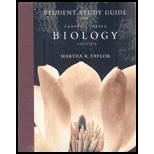
Concept explainers
In what way(s) do mycorrhizal
In what way(s) do plants benefit the fungi?
To describe:
The ways by which the mycorrhizal fungi benefit plants.
Introduction:
Fungus is a eukaryotic heterotrophic organism that falls under the kingdom Fungi. This organism either forms a symbiotic or parasitic relationship with animals or plants and some fungi occurs as free-living in water or soil. The examples of fungi are mildews, molds, yeasts, rusts, mushrooms, and so on. The reproduction of fungus occurs as both sexual and asexual reproduction, which produces spores. Many fungi play an important role in the field of biochemistry, genetic engineering, metabolism, and medicine.
Explanation of Solution
The body structure of the fungi is generally made up of multicellular filaments that consist of the filamentous network called as hyphae. This structure combines and forms a mass of filaments called as mycelium. The hyphae are divided into cells by the structure called as septa that contain spores through which the nutrients are passed. Mycorrhizal Fungi contain special hyphae that involve in the trapping of roots and stems of plants. This fungus shares the symbiotic relationship or mutualistic association with the plants thereby it both gains and provides the nutrients for the growth process. After colonizing, the mycorrhizal fungi increase the surface area in the roots of the plants, and thereby it provides the inorganic phosphate ions, organic nitrogen, water, and other minerals to the plants. It also involves in the aeration of lands through gas exchange and thereby it increases the yield of plants.
To describe:
The ways by which the plants benefit the fungi.
Explanation of Solution
The body structure of the fungi is generally made up of multicellular filaments that consist of the filamentous network called as hyphae. This structure combines and forms a mass of filaments called as mycelium. Mycorrhizal Fungi contain the special hyphae that involve in the trapping of roots and stems of plants. This fungus shares the symbiotic relationship or mutualistic association with the plants and thereby it both gains and provides the nutrients for the growth process. Since it is a mutualistic association, the plants provide the organic nutrients and carbohydrates as a carbon source and energy to the fungi through photosynthesis.
Want to see more full solutions like this?
Chapter 31 Solutions
Biology - Study Guide
Additional Science Textbook Solutions
Microbiology: Principles and Explorations
Anatomy & Physiology (6th Edition)
Biology: Concepts and Investigations
Essentials of Human Anatomy & Physiology (12th Edition)
Concepts of Genetics (12th Edition)
Genetics: From Genes to Genomes, 5th edition
- What are mycorrhizae? and what are the different types of mycorrhizae, mention two examples of fungi that form mycorrhizae with economically important plants.arrow_forwardEcologists often attempt to introduce new plants to restore degraded land. In an arid climate, scientists recommend introducing plants with arbuscular mycorrhizae. How would the mycorrhizae increase the plants’ survival compared to plants without mycorrhizae?arrow_forwardHow are mycorrhizae and root nodules similar? How are they different?arrow_forward
- What is a mycorrhizal association? What benefit does the plant derive from the association?arrow_forwardIn mycorrhizal associations with plants what are the structures produced by VAM fungi and Ectomycorrhizal fungi to facilitate the exchange of nutrients, and how do they differ?arrow_forwardHow do mycorrhizal fungi promote plant diversity?arrow_forward
- How is the mycorrhizal association helpful in absorption of water and minerals in plants?arrow_forwardWhat are mycorrhizae? Discuss the different types in detail and give two examples of fungi that form mycorrhizae with economically important plants.arrow_forwardMycorrhizal fungi live in the soil and interact with the roots of plants. Essentail nutrients (e.g. nitrogenous compounds) are taken from the soil by the fungi and transferred to the plant roots. The fungi extract carbohydrates from the plant roots. What type of interaction is occurring?arrow_forward
- Suppose that a mutation of a basidiomycete changed its lifecycle to cause premature plasmogamy, karyogamy and meiosis. How might this affect the spores and basidiocarp?arrow_forwardGlomeromycete fungi and plants take part in a mycorrhiza that ____. benefits the plant, but harms the fungus benefits the fungus, but harms the plant harms both the plant and the fungus allows the fungus to use its host to disperse spores benefits both the plant and the fungusarrow_forwardEcologists often attempt to introduce new plants to restore degraded land. In an arid climate, scientists recommend introducing plants with arbuscular mycorrhizae. How would the mycorrhizae increase the plants’ survival compared to plants without mycorrhizae?arrow_forward

 Biology (MindTap Course List)BiologyISBN:9781337392938Author:Eldra Solomon, Charles Martin, Diana W. Martin, Linda R. BergPublisher:Cengage Learning
Biology (MindTap Course List)BiologyISBN:9781337392938Author:Eldra Solomon, Charles Martin, Diana W. Martin, Linda R. BergPublisher:Cengage Learning Biology Today and Tomorrow without Physiology (Mi...BiologyISBN:9781305117396Author:Cecie Starr, Christine Evers, Lisa StarrPublisher:Cengage Learning
Biology Today and Tomorrow without Physiology (Mi...BiologyISBN:9781305117396Author:Cecie Starr, Christine Evers, Lisa StarrPublisher:Cengage Learning Biology 2eBiologyISBN:9781947172517Author:Matthew Douglas, Jung Choi, Mary Ann ClarkPublisher:OpenStax
Biology 2eBiologyISBN:9781947172517Author:Matthew Douglas, Jung Choi, Mary Ann ClarkPublisher:OpenStax Biology: The Unity and Diversity of Life (MindTap...BiologyISBN:9781305073951Author:Cecie Starr, Ralph Taggart, Christine Evers, Lisa StarrPublisher:Cengage Learning
Biology: The Unity and Diversity of Life (MindTap...BiologyISBN:9781305073951Author:Cecie Starr, Ralph Taggart, Christine Evers, Lisa StarrPublisher:Cengage Learning




